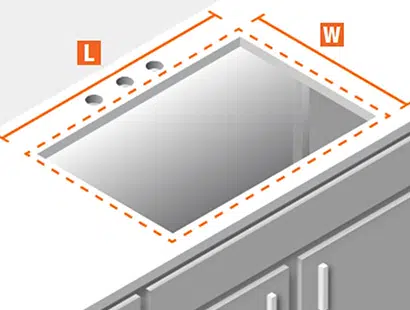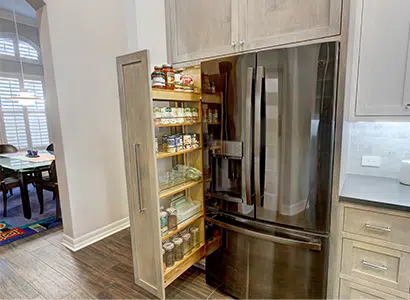Whether you are doing a remodel or a kitchen build, there are a plethora of details that require your attention. Most of us think about cabinet style, countertops, and the type of appliances, but can easily overlook cabinet knob or pull placement. Cabinet handle and pull placement can really change the overall look and feel of your cabinets. Minor changes in cabinet handle placement not only impact the balance of the design but also affect how you feel when engaging with your kitchen daily.
This article provides a basic overview of kitchen cabinet knob location, best practices for various cabinet types, and confirms that cabinet door knob placement is both visually appealing and functional.
Why Cabinet Knob Placement Matters
Usually, average people will think that cabinet door handles can be placed almost anywhere, as long as the location is “visually right.” Usually, that is not the case. It is important to consider several factors when positioning your cabinet door handles:
- Convenience of Use: The knob should be located where it can be most conveniently used to open and close, avoiding heights that are either too high or too low. For example, knobs for upper cabinets are typically installed in the lower corners of the door panels—2.5-3 inches in from the edge of the door—while for lower cabinets, rings are generally installed at the upper corners of the door panels with the same 2.5-3 inch in distance from the edge. For drawers, normally the knob is located in the center of the drawer panel, or you can install a knob on either end of a wide drawer panel to ease operation.
- Visual Balance: Knobs should also be placed where visually balanced. Placing knobs on cabinets in a mirrored, symmetrical manner will provide a clean, linear feel. It is also advisable to place knobs or pulls in the same location and at the same height as other hardware, like handles, to avoid uneven placement.
- Strength: Properly placed handles and pulls will place less stress on hinges and edges, allowing for greater strength and durability, freeing up expenses down the line.
- Style: Or in other words, handle placement can alter the style of cabinet doors, allowing for modern clean lines, transitional appeal, or rich traditional feel.
Finding the “sweet spot” for the handle location is hard because it is often a trade-off between resource use and utility.
Standard Cabinet Door Knob Placement

When installing hardware, designers and carpenters typically adhere to a set of professional standards. Although every project is customizable, these standards generally allow for balance and function:
- Upper Cabinets (Wall Cabinets)
In well-planned and well-reviewed locations, hardware should be placed on the bottom corner of the door, but opposite the hinge.
Typical measurement would be 2.5 – 3 inches up from the bottom and 1 – 1.5 inches in from the side.
- Lower Cabinets (Base Cabinets)
Hardware usually should be placed on the top corner of the door but opposite the hinge.
Typical measurement would be 2.5 – 3 inches down from the top and 1 – 1.5 inches in from the edge.
The above examples guarantee a consistent look, and they begin with a smooth door opening with the hand in a comfortable position, not funky.
Kitchen Cabinet Knob Placement by Style
Every kitchen has a personality, and when placing knobs on the kitchen cabinets, the placement should reflect that throughout the design.
Shaker Cabinets
For this classic design, knobs are typically centered on the rail (the horizontal frame), and this is done for symmetry and to keep the traditional look.
Modern Flat-Panel Cabinets
With flat-panel cabinets, the form follows a clean line or lines. The knobs and pulls are typically aligned together, the knobs across the upper cabinets, and pulls on the lower cabinets – all uniform and minimalist.
Furniture-Style Cabinets
In kitchen designs based on farmhouse or vintage looks, the knob placement on cabinet doors might replicate antique furniture. The knobs are often centered, or maybe a little off-center for decorative effect.
Tall Pantry Cabinets
Functionality is key here. The height of the knobs or long handles should be comfortable for the user, generally 36-42 inches from the floor.
Knob and Handle Placement on Cabinets
Not all hardware is the same. Many kitchens utilize a combination of knobs and pulls. A general rule of thumb for knob and handle placement on cabinets is:
Cabinet Doors: location of the knob on the edge opposite the hinge.
Small Drawers: one knob, once centered vertically and horizontally
Large Drawers: two knobs, uniformly spaced or one pull, centered
Tall Cabinets: long vertical pulls, which could act both as a design and functional element.
Consistency is important. Even when using different knobs and pulls and depending on the shape(s) they provide, as long as lines are lined up, things feel harmonious.
Tips for Correct Knob Placement on Cabinets
If you want to have professional results with the placement of your knobs on cabinet doors, take into consideration the following tips;
Try First: Use painter’s tape to temporarily “stick” knobs in place to see how they feel and look.
Use Templates: hardware jigs ensure precision and repeatability.
Align With Other Elements: Align knob lines with counter tops, drawer fronts, or appliances.
Avoid Edges: Don’t install knobs too close to the edge of the cabinet, as this can cause damage over time.
Ergonomics are Key: Since kitchen cabinets are used daily, make sure the knob placement on the kitchen cabinets feels natural.
Common Errors to Steer Clear of
- Mounting knobs at different heights on different cabinets.
- Mounting the hardware too close to the edge of the cabinet so it cannot be properly gripped, and the hardware wears improperly.
- Drawers come in different sizes, but once a drawer is wider, people tend to install two knobs or use handles directly, which makes it easier to open and close.
- Not considering the surrounding design elements around the cabinetry, like appliances.
The cabinetry will look polished and function properly by avoiding these common errors.
Conclusion
Determining cabinet knob location is not just another finishing detail – it is also a design decision that has ramifications on comfort, durability, and style. This is also true for the placement of kitchen cabinet knobs, but we want to be aware of the placement of the cabinet door knobs. If you follow these guidelines, you will have a professional and consistent look and feel to your cabinetry.
The best possible results come by balancing the right measurements with your style and the overall layout of your kitchen. If you put in the time and effort into planning, the placement of cabinet knobs can enhance the entire space and make using it every day that much better.
FAQ
Q1: What is the normal cabinet knob placement?
A1: Normal cabinet knob placement is generally anywhere from 2.5″ to 3″ from the corner of the cabinet door. Those distances will create a similar spacing for both a decorative look as well as ease of gripping for opening the door.
Q2: How do I determine cabinet knob placement?
A2: Typically, when placing kitchen cabinet knobs, they are generally installed on the lower corner of the upper cabinet doors and the upper corner of the base cabinet doors to create similar access and visual consistency.
Q3: Where should cabinet door knobs be placed?
A3: The typical cabinet door knob placement is generally around 2.5″ from the bottom corner of the upper door frame, or the top corner of the lower cabinet door. Just remember to always place the knobs where it is natural for the hand to reach.
Related Resouce:



